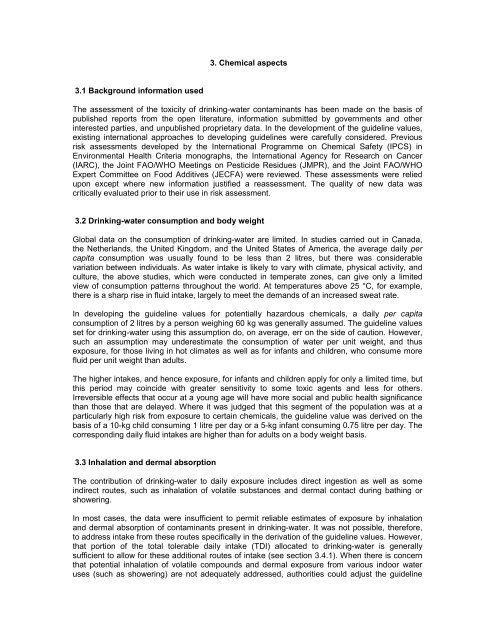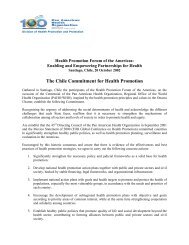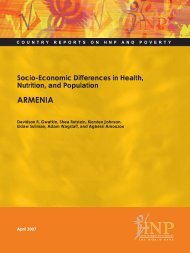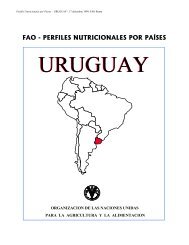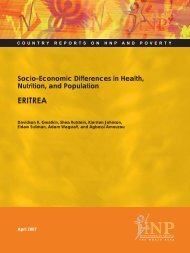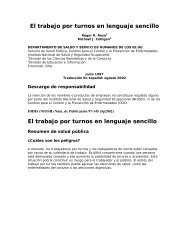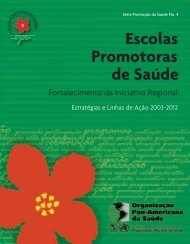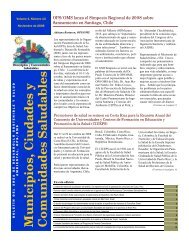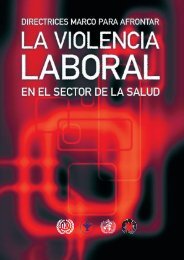Guidelines for drinking-water quality. Volume 1 - BVSDE
Guidelines for drinking-water quality. Volume 1 - BVSDE
Guidelines for drinking-water quality. Volume 1 - BVSDE
You also want an ePaper? Increase the reach of your titles
YUMPU automatically turns print PDFs into web optimized ePapers that Google loves.
3. Chemical aspects<br />
3.1 Background in<strong>for</strong>mation used<br />
The assessment of the toxicity of <strong>drinking</strong>-<strong>water</strong> contaminants has been made on the basis of<br />
published reports from the open literature, in<strong>for</strong>mation submitted by governments and other<br />
interested parties, and unpublished proprietary data. In the development of the guideline values,<br />
existing international approaches to developing guidelines were carefully considered. Previous<br />
risk assessments developed by the International Programme on Chemical Safety (IPCS) in<br />
Environmental Health Criteria monographs, the International Agency <strong>for</strong> Research on Cancer<br />
(IARC), the Joint FAO/WHO Meetings on Pesticide Residues (JMPR), and the Joint FAO/WHO<br />
Expert Committee on Food Additives (JECFA) were reviewed. These assessments were relied<br />
upon except where new in<strong>for</strong>mation justified a reassessment. The <strong>quality</strong> of new data was<br />
critically evaluated prior to their use in risk assessment.<br />
3.2 Drinking-<strong>water</strong> consumption and body weight<br />
Global data on the consumption of <strong>drinking</strong>-<strong>water</strong> are limited. In studies carried out in Canada,<br />
the Netherlands, the United Kingdom, and the United States of America, the average daily per<br />
capita consumption was usually found to be less than 2 litres, but there was considerable<br />
variation between individuals. As <strong>water</strong> intake is likely to vary with climate, physical activity, and<br />
culture, the above studies, which were conducted in temperate zones, can give only a limited<br />
view of consumption patterns throughout the world. At temperatures above 25 °C, <strong>for</strong> example,<br />
there is a sharp rise in fluid intake, largely to meet the demands of an increased sweat rate.<br />
In developing the guideline values <strong>for</strong> potentially hazardous chemicals, a daily per capita<br />
consumption of 2 litres by a person weighing 60 kg was generally assumed. The guideline values<br />
set <strong>for</strong> <strong>drinking</strong>-<strong>water</strong> using this assumption do, on average, err on the side of caution. However,<br />
such an assumption may underestimate the consumption of <strong>water</strong> per unit weight, and thus<br />
exposure, <strong>for</strong> those living in hot climates as well as <strong>for</strong> infants and children, who consume more<br />
fluid per unit weight than adults.<br />
The higher intakes, and hence exposure, <strong>for</strong> infants and children apply <strong>for</strong> only a limited time, but<br />
this period may coincide with greater sensitivity to some toxic agents and less <strong>for</strong> others.<br />
Irreversible effects that occur at a young age will have more social and public health significance<br />
than those that are delayed. Where it was judged that this segment of the population was at a<br />
particularly high risk from exposure to certain chemicals, the guideline value was derived on the<br />
basis of a 10-kg child consuming 1 litre per day or a 5-kg infant consuming 0.75 litre per day. The<br />
corresponding daily fluid intakes are higher than <strong>for</strong> adults on a body weight basis.<br />
3.3 Inhalation and dermal absorption<br />
The contribution of <strong>drinking</strong>-<strong>water</strong> to daily exposure includes direct ingestion as well as some<br />
indirect routes, such as inhalation of volatile substances and dermal contact during bathing or<br />
showering.<br />
In most cases, the data were insufficient to permit reliable estimates of exposure by inhalation<br />
and dermal absorption of contaminants present in <strong>drinking</strong>-<strong>water</strong>. It was not possible, there<strong>for</strong>e,<br />
to address intake from these routes specifically in the derivation of the guideline values. However,<br />
that portion of the total tolerable daily intake (TDI) allocated to <strong>drinking</strong>-<strong>water</strong> is generally<br />
sufficient to allow <strong>for</strong> these additional routes of intake (see section 3.4.1). When there is concern<br />
that potential inhalation of volatile compounds and dermal exposure from various indoor <strong>water</strong><br />
uses (such as showering) are not adequately addressed, authorities could adjust the guideline


